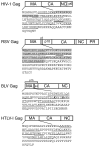Beyond plasma membrane targeting: role of the MA domain of Gag in retroviral genome encapsidation
- PMID: 21762800
- PMCID: PMC3328307
- DOI: 10.1016/j.jmb.2011.04.072
Beyond plasma membrane targeting: role of the MA domain of Gag in retroviral genome encapsidation
Abstract
The MA (matrix) domain of the retroviral Gag polyprotein plays several critical roles during virus assembly. Although best known for targeting the Gag polyprotein to the inner leaflet of the plasma membrane for virus budding, recent studies have revealed that MA also contributes to selective packaging of the genomic RNA (gRNA) into virions. In this Review, we summarize recent progress in understanding how MA participates in genome incorporation. We compare the mechanisms by which the MA domains of different retroviral Gag proteins influence gRNA packaging, highlighting variations and similarities in how MA directs the subcellular trafficking of Gag, interacts with host factors and binds to nucleic acids. A deeper understanding of how MA participates in these diverse functions at different stages in the virus assembly pathway will require more detailed information about the structure of the MA domain within the full-length Gag polyprotein. In particular, it will be necessary to understand the structural basis of the interaction of MA with gRNA, host transport factors and membrane phospholipids. A better appreciation of the multiple roles MA plays in genome packaging and Gag localization might guide the development of novel antiviral strategies in the future.
Copyright © 2011 Elsevier Ltd. All rights reserved.
Figures


Similar articles
-
Retroviral Gag protein-RNA interactions: Implications for specific genomic RNA packaging and virion assembly.Semin Cell Dev Biol. 2019 Feb;86:129-139. doi: 10.1016/j.semcdb.2018.03.015. Epub 2018 Apr 1. Semin Cell Dev Biol. 2019. PMID: 29580971 Free PMC article. Review.
-
Visualization of Retroviral Gag-Genomic RNA Cellular Interactions Leading to Genome Encapsidation and Viral Assembly: An Overview.Viruses. 2022 Feb 5;14(2):324. doi: 10.3390/v14020324. Viruses. 2022. PMID: 35215917 Free PMC article. Review.
-
[Membrane Binding of Retroviral Gag Proteins].Uirusu. 2014;64(2):155-64. doi: 10.2222/jsv.64.155. Uirusu. 2014. PMID: 26437838 Review. Japanese.
-
New insights into the nuclear localization of retroviral Gag proteins.Nucleus. 2011 Mar-Apr;2(2):92-7. doi: 10.4161/nucl.2.2.15018. Nucleus. 2011. PMID: 21738831 Free PMC article.
-
Visualizing Association of the Retroviral Gag Protein with Unspliced Viral RNA in the Nucleus.mBio. 2020 Apr 7;11(2):e00524-20. doi: 10.1128/mBio.00524-20. mBio. 2020. PMID: 32265329 Free PMC article.
Cited by
-
Post-Translational Modifications of Retroviral HIV-1 Gag Precursors: An Overview of Their Biological Role.Int J Mol Sci. 2021 Mar 11;22(6):2871. doi: 10.3390/ijms22062871. Int J Mol Sci. 2021. PMID: 33799890 Free PMC article. Review.
-
The Rous sarcoma virus Gag Polyprotein Forms Biomolecular Condensates Driven by Intrinsically-disordered Regions.J Mol Biol. 2023 Aug 15;435(16):168182. doi: 10.1016/j.jmb.2023.168182. Epub 2023 Jun 14. J Mol Biol. 2023. PMID: 37328094 Free PMC article.
-
Cytoplasmic utilization of human immunodeficiency virus type 1 genomic RNA is not dependent on a nuclear interaction with gag.J Virol. 2012 Mar;86(6):2990-3002. doi: 10.1128/JVI.06874-11. Epub 2012 Jan 18. J Virol. 2012. PMID: 22258250 Free PMC article.
-
Mechanistic differences between nucleic acid chaperone activities of the Gag proteins of Rous sarcoma virus and human immunodeficiency virus type 1 are attributed to the MA domain.J Virol. 2014 Jul;88(14):7852-61. doi: 10.1128/JVI.00736-14. Epub 2014 Apr 30. J Virol. 2014. PMID: 24789780 Free PMC article.
-
Retrovirus-specific differences in matrix and nucleocapsid protein-nucleic acid interactions: implications for genomic RNA packaging.J Virol. 2014 Jan;88(2):1271-80. doi: 10.1128/JVI.02151-13. Epub 2013 Nov 13. J Virol. 2014. PMID: 24227839 Free PMC article.
References
-
- Swanstrom R, Wills JW. Synthesis, assembly, and processing of viral proteins. In: Coffin JM, Hughes SH, Varmus HE, editors. Retroviruses. Cold Spring Harbor Laboratory Press; 1997. pp. 263–334. - PubMed
-
- Berkowitz R, Fisher J, Goff SP. RNA packaging. Curr.Top.Microbiol.Immunol. 1996;214:177–218. - PubMed
-
- Rein A. Retroviral RNA packaging: a review. Arch.Virol.Suppl. 1994;9:513–522. - PubMed
-
- Jewell NA, Mansky LM. In the beginning: genome recognition, RNA encapsidation and the initiation of complex retrovirus assembly. J Gen Virol. 2000;81(Pt 8):1889–1899. - PubMed
Publication types
MeSH terms
Substances
Grants and funding
LinkOut - more resources
Full Text Sources

